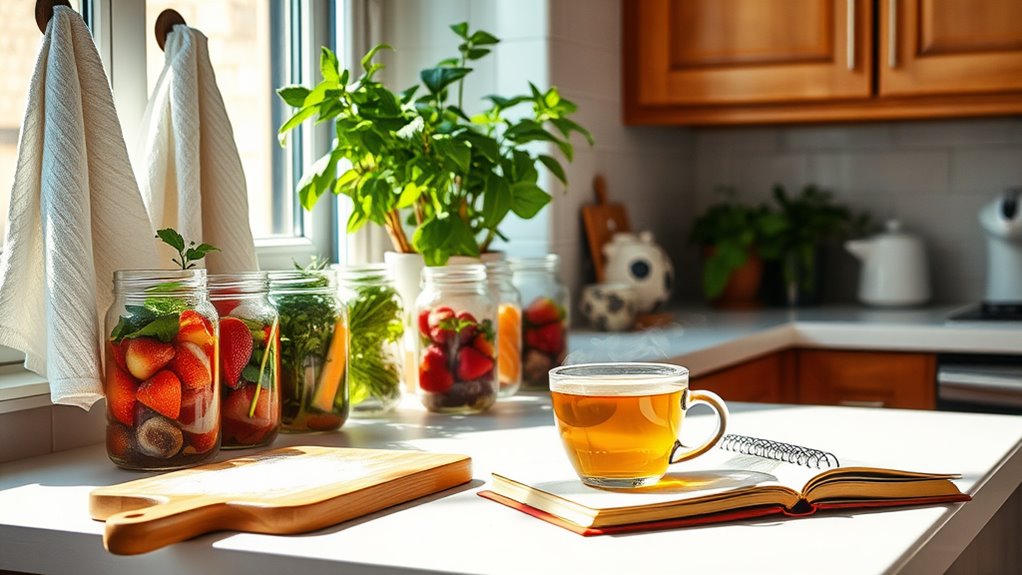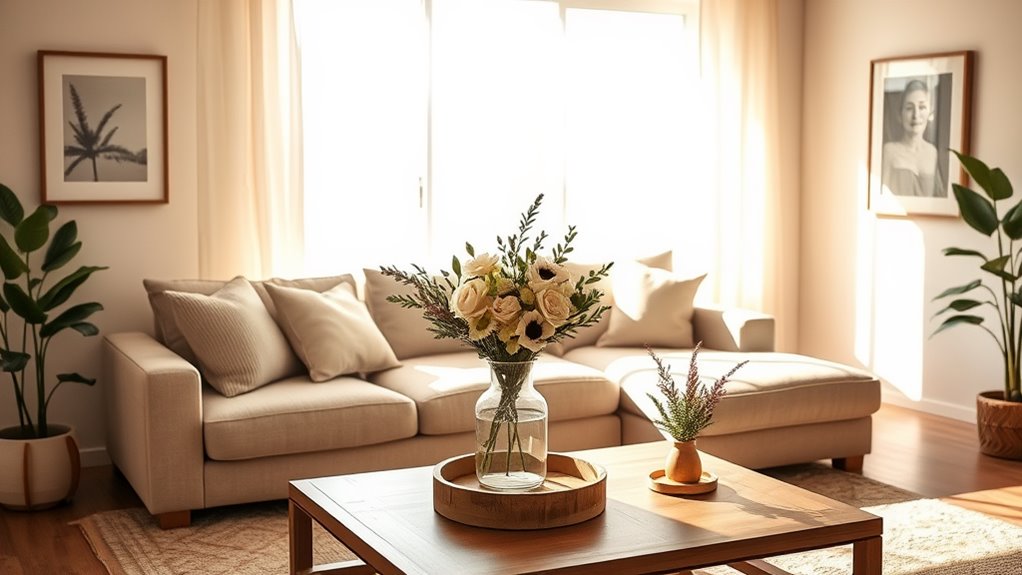A Weekly Home Reset to Keep Your Living Space Perfect!
To keep your living space perfect, start with a weekly home reset. Begin by evaluating each room’s functionality and decluttering high-traffic areas to maintain smooth movement. Organize your storage solutions with clear bins and baskets for easy access. Dedicate time to thoroughly clean surfaces, ensuring your home stays fresh. Don’t forget to refresh fabrics by washing soft furnishings and rotating decor. Create a cozy relaxation zone away from distractions, and establish weekly maintenance habits to stay on track. With these simple steps, you’ll create an inviting atmosphere conducive to comfort and calm. You might discover more effective tips ahead!
Key Takeaways
- Dedicate a specific day each week for thorough surface cleaning and decluttering to maintain a fresh and organized environment.
- Assess and adjust storage solutions regularly to ensure items are easily accessible and grouped by category for efficiency.
- Clear high-traffic areas of unnecessary items to promote smooth navigation and a clutter-free atmosphere.
- Rotate seasonal decor and refresh fabrics to keep the living space vibrant and inviting.
- Establish designated relaxation zones with cozy elements to encourage unwinding and balance in daily life.
Assess Your Space
Evaluating your space is an essential step in creating a harmonious home environment. Start by examining each room’s functionality. Consider how you use the space daily and whether it serves its intended purpose.
Walk through your home and take notes on what works and what feels chaotic. Are there areas that feel cramped or neglected?
Next, think about the flow of movement. Can you navigate easily, or do obstacles block your path? A well-functioning room should allow for seamless changes between activities.
Identify any furniture pieces that might be hindering your space’s effectiveness.
As you conduct your space evaluation, also pay attention to the emotional atmosphere. Does the room evoke a sense of calm, or is it overwhelming? Adjustments might be as simple as rearranging furniture or adding storage solutions to enhance functionality.
Finally, keep in mind that every space should reflect your personal style while serving its purpose. Prioritize what matters most to you, and remember, a well-examined space paves the way for a more organized and tranquil home.
With this foundation, you’ll be better prepared for the next steps in your weekly home reset.
Declutter High-Traffic Areas
Once you’ve assessed your space, it’s time to focus on decluttering high-traffic areas. These zones, like entryways and living rooms, are essential for maintaining smooth traffic flow. Implementing effective declutter strategies here can greatly enhance your living experience.
Start by clearing surfaces and removing items that don’t belong. Use a systematic approach: tackle one area at a time and decide what to keep, donate, or discard. Aim to keep pathways clear, allowing for easy movement throughout your home.
Here’s a straightforward table to guide your decluttering efforts:
| Area | Common Clutter | Declutter Strategy |
|---|---|---|
| Entryway | Shoes, bags, mail | Designate a shoe rack, basket for bags, and a mail organizer. |
| Living Room | Books, blankets, gadgets | Use a basket for blankets, and limit books to a designated shelf. |
| Kitchen Counter | Appliances, papers | Store appliances in cabinets and sort papers into a filing system. |
Organize Storage Solutions
When it comes to organizing your storage solutions, prioritizing functionality is essential. Start with selecting the right storage bins—opt for clear, stackable options to maximize visibility and accessibility. Label each bin clearly to guarantee you can find what you need quickly, whether it’s seasonal items, craft supplies, or sports gear.
Next, consider the use of shelving units. They’re invaluable for creating vertical space in your home. Install adjustable shelving to accommodate items of varying sizes, from books to decorative boxes. This adaptability allows you to reorganize as your storage needs change over time.
Placement is also vital; position shelving units in high-traffic areas where you can easily access them without disrupting your workflow. Group similar items together to streamline your routine and maintain order.
Lastly, regularly assess your storage solutions. As your lifestyle evolves, so will your storage requirements. Don’t hesitate to re-evaluate your setup, making sure it continues to serve its purpose effectively.
Clean Surfaces Thoroughly
With your storage solutions organized, it’s time to focus on maintaining a clean environment. Start by identifying the various surface types in your home—kitchen counters, bathroom sinks, and living room tables, for example. Each surface may require different cleaning products to guarantee they’re not only clean but also well-maintained.
For hard surfaces like wood or laminate, choose gentle, pH-balanced cleaners to avoid damage. Microfiber cloths work wonders for dusting and wiping these surfaces without leaving scratches. When tackling glass, a streak-free cleaner will give you that crystal-clear finish.
In the kitchen, disinfectant wipes or sprays are essential for surfaces that come into contact with food. Don’t forget to pay attention to high-touch areas like light switches and doorknobs, where germs can accumulate.
For bathrooms, a good quality bathroom cleaner can eliminate soap scum and mildew. Regularly scrubbing tiles and sinks guarantees they stay fresh and hygienic.
Set aside time weekly to clean these surfaces thoroughly, and you’ll create a welcoming environment that reflects your mastery of home maintenance.
Consistency is key—your living space deserves it!
Refresh Fabrics and Textiles
Now that you’ve cleaned your surfaces, it’s time to refresh your fabrics and textiles.
Start by washing your soft furnishings to eliminate dust and allergens, and don’t forget to rotate your seasonal decor for a fresh look.
This simple step can make a big difference in how your space feels.
Wash Soft Furnishings
Although it might seem like an intimidating task, washing your soft furnishings is essential for maintaining a fresh and inviting home environment.
By incorporating regular soft furnishings care into your routine, you can enhance not only the appearance but also the longevity of your fabrics.
Here are some effective fabric cleaning tips to take into account:
-
Check Labels: Always look at the care labels before washing. Different fabrics have unique cleaning requirements, so knowing the right method is vital.
-
Spot Clean: For minor stains, spot cleaning is often sufficient. Use a gentle detergent and a clean cloth to treat the area without soaking the entire fabric.
-
Use the Right Settings: When machine washing, select a gentle cycle with cold water. This helps preserve the fabric’s integrity while still providing a thorough clean.
Rotate Seasonal Decor
After you’ve refreshed your soft furnishings, it’s the perfect time to rotate your seasonal decor. This step is essential for maintaining a vibrant living space that reflects the current seasonal themes.
Start by evaluating what decor you have for each season. Create a checklist of items you want to display, ensuring they align with your overall aesthetic.
Once you’ve identified your seasonal decor, carefully curate your selections. Remove any decor that no longer fits your vision or is out of season. Store these items in labeled bins for easy access next time.
As you bring out your new decor, think about how you can incorporate various textures and colors to enhance your space.
Consider how decor rotation affects your ambiance. For example, warm tones and cozy textures work well in autumn, while light fabrics and bright hues suit spring. By strategically rotating your decor, you not only refresh your space but also create an inviting atmosphere that feels timely and intentional.
Lastly, don’t forget to rearrange existing pieces to keep things fresh. This simple shift can dramatically change your space’s feel and function, making it a delight to come home to.
Revitalize Indoor Plants
As winter gives way to spring, it’s the perfect time to breathe new life into your indoor plants. Proper plant care can greatly enhance your indoor gardening experience and guarantee your green friends thrive as the seasons change.
Here are three essential steps to revitalize your indoor plants:
-
Inspect for Pests: Check each plant for signs of pests like spider mites or aphids. Early detection is vital for effective treatment, so don’t overlook this step.
-
Repot if Necessary: If you notice roots growing out of the pot or stunted growth, it’s time to repot. Choose a slightly larger container with fresh potting mix to provide your plants with the nutrients they need.
-
Adjust Watering Routine: As temperatures rise, your plants may require more frequent watering. Pay attention to the moisture level in the soil and adjust your schedule accordingly to avoid under- or over-watering.
Create a Relaxation Zone
Creating a relaxation zone in your home can be a simple yet effective way to unwind.
Start by choosing a quiet space where you can escape daily distractions.
Then incorporate cozy elements like soft blankets and cushions.
Finally, add calming decor that resonates with you, helping to establish a serene atmosphere.
Choose a Quiet Space
Finding a quiet space in your home can greatly enhance your relaxation experience.
Designating a specific area for unwinding helps you mentally separate work from leisure, promoting a more balanced lifestyle. Whether it’s a meditation corner or a nook in your home office, the right environment can work wonders.
Here are three tips to create your quiet space:
-
Choose the Right Location: Select a spot away from high-traffic areas. Ideally, it should be separate from your home office to minimize distractions.
-
Reduce Noise: Use soundproofing techniques, like heavy curtains or rugs, to dampen noise. If external sounds persist, consider a white noise machine or soft background music to create an auditory barrier.
-
Limit Distractions: Keep electronics to a minimum. If your meditation corner doubles as a workspace, make certain that work-related materials are out of sight when you’re there to relax.
Incorporate Cozy Elements
Once you’ve established your quiet space, the next step is to make it truly inviting. To create a relaxation zone, focus on incorporating cozy elements that enhance comfort and tranquility.
Start with cozy lighting. Soft, warm lights can transform your area, so consider using string lights, table lamps, or candles to provide an ambient glow. This gentle illumination helps create a peaceful atmosphere that encourages unwinding.
Next, introduce warm textiles. Layering soft throw blankets and plush cushions can make your space feel more inviting. Choose materials like fleece or knitted fabrics that invite touch and provide warmth.
Don’t hesitate to mix textures; a combination of smooth and fuzzy elements adds depth to your relaxation zone.
Finally, arrange your seating to promote comfort. Make sure that your chair or sofa is positioned for ideal relaxation, perhaps with a view of a window or a favorite piece of art.
By thoughtfully integrating cozy lighting and warm textiles, you’ll cultivate a space that beckons you to escape from the chaos of daily life, allowing you to recharge and find peace.
Enjoy your newly transformed relaxation zone!
Add Calming Decor
To enhance your relaxation zone, adding calming decor can make a considerable difference.
By creating an environment that promotes peace and tranquility, you’ll find it easier to unwind after a long day.
Focus on incorporating elements that feature calming colors and soothing textures.
Here are three effective ways to achieve this:
- Choose Calming Colors: Opt for soft hues like pastel blues, gentle greens, or warm neutrals.
These colors naturally evoke a sense of calm and can considerably influence your mood.
- Incorporate Soothing Textures: Introduce plush pillows, soft throws, or a cozy area rug.
Textiles with varying textures can add depth to your space, making it more inviting and comforting.
- Add Natural Elements*: Bring in some greenery with *indoor plants or flowers.
The presence of nature not only enhances the aesthetic but also contributes to a peaceful ambiance.
Establish Weekly Maintenance Habits
Establishing weekly maintenance habits can make a significant difference in keeping your home organized and stress-free. By incorporating structured weekly routines, you’ll create a sense of order that enhances your living experience.
Start by developing a maintenance checklist tailored to your home’s unique needs. This will help you stay on track and guarantee nothing gets overlooked.
Begin each week by dedicating a specific day for your maintenance tasks. This could involve cleaning, decluttering, or minor repairs. For instance, set aside Sunday to go through your living spaces, ensuring everything is in its place. Tackle one room at a time, and use your checklist to guide you through essential tasks.
Additionally, consider adding a “reset” session at the end of each week. This can be a quick 30-minute routine where you refresh common areas, restock supplies, and prepare for the week ahead.
Frequently Asked Questions
How Long Does a Weekly Home Reset Typically Take?
A weekly home reset typically takes about two to three hours, depending on your time management skills and weekly schedule. Prioritizing tasks effectively can streamline the process, making it efficient and less overwhelming for you.
What Tools Are Essential for an Effective Home Reset?
To master your home reset, you’ll need essential cleaning gadgets like a vacuum and microfiber cloths, alongside organization tools such as bins and labels. These will transform chaos into order, creating a serene living space.
How Can I Motivate Myself to Maintain a Weekly Routine?
To motivate yourself for a weekly routine, focus on goal setting to clarify your objectives. Implement a reward system for achieving milestones; it’ll create positive reinforcement, making the process enjoyable and sustainable over time.
Are There Specific Cleaning Products You Recommend for Surfaces?
Imagine a sparkling kitchen, every surface gleaming under the sunlight. For that, you’ll want eco-friendly cleaners and effective surface disinfectants. Brands like Method and Seventh Generation are excellent choices for a clean, responsible home.
How Often Should I Refresh Indoor Plants?
You should refresh your indoor plants every 4-6 weeks. This practice enhances plant care, ensuring they receive adequate nutrients and water. Regularly check for signs of distress, adjusting your indoor gardening routine as needed.



